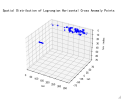Dear all,
I'm trying to run CESM2.1.3 with FW2010climo compset, and resolution is f09_f09_mg17. I'm able to run the case successfully.
However, when ERA5 was used to analyze the temperature data in the lower and middle atmosphere by replacing the data with ERA5 (WACCM climatology was used for atmospheres above 0.01hPa, ERA5 and WACCM climatology were fused with inverse linear weights from 0.01 to 0.1hPa, and ERA5 was used for atmospheres below 0.1hPa), an error was reported as follows:

We plot the vertical temperature profile at the anomaly location, and find that there is a significant difference between the default initial field of the stratospheric model and the fused initial field in the stratosphere.

Seven hours into the simulation, there's a lot of wind on the upper floors.

We've tried to analyze the reason for the Lagrange cross, but we still don't know what the real reason is.
Any suggestions would be greatly helpful!
Thanks in advance!
I'm trying to run CESM2.1.3 with FW2010climo compset, and resolution is f09_f09_mg17. I'm able to run the case successfully.
However, when ERA5 was used to analyze the temperature data in the lower and middle atmosphere by replacing the data with ERA5 (WACCM climatology was used for atmospheres above 0.01hPa, ERA5 and WACCM climatology were fused with inverse linear weights from 0.01 to 0.1hPa, and ERA5 was used for atmospheres below 0.1hPa), an error was reported as follows:
By modifying the source code, we have commented out the termination of the exception when it occurs, and the program can continue to compute, but the interruption usually occurs after a short period of time. so we printed out the Lagrangian horizontal crossings of the anomalies by modifying the source code, and found that they were mainly in the high latitudes of the upper atmosphere.Lagrangian levels are crossing 9.999999999999999E-012
Run will ABORT!
Suggest to increase NSPLTVRM
ERROR: te_map: Lagrangian levels are crossing

We plot the vertical temperature profile at the anomaly location, and find that there is a significant difference between the default initial field of the stratospheric model and the fused initial field in the stratosphere.

Seven hours into the simulation, there's a lot of wind on the upper floors.

We've tried to analyze the reason for the Lagrange cross, but we still don't know what the real reason is.
Any suggestions would be greatly helpful!
Thanks in advance!
